Serengeti 2025 Trip Report
- pscrimshaw

- May 5
- 15 min read
I seem to be making a habit out of unplanned travel. In November I ended up visiting the Maasai Mara completely on a whim, and now I found myself booking a trip to the Serengeti and then flying out the following day. I promise this isn't usually how I do things, but life gave me an opportunity to travel and I wasn't about to let that slip away!
Last year I visited the Serengeti for the very first time, and I have to admit, I was a bit underwhelmed. I thought that visiting the most iconic park in Africa would mean that I would be treated to some incredible wildlife sightings, but the reality was that I saw virtually no animals around. It got so bad that I ended up photographing trees just to pass the time. And even when we did occasionally get lucky and find a lion or cheetah, there were so many other vehicles around the central area where we were staying that it became a chaotic and unpleasant experience.
But for the last couple of years, I had heard about a hidden gem of the Serengeti known as Namiri Plains. Tucked away in the rarely visited eastern part of the park, Namiri Plains is famous for some of the best big cat photography anywhere in the world. The types of shots that I was seeing out of Namiri made me absurdly jealous, and while the exclusivity of this area came with a painful price tag, I knew that if I wanted to do Serengeti right, that I had to come to Namiri. So after several back and forth emails/phone calls with my booking agent, I planned a last minute trip to Namiri Plains, and hoped that I would be able to come away with my own award winning wildlife photos!
It was a long flight from Seattle to Tanzania, but as soon as I saw the snow capped peak of Mt. Kilimanjaro, I knew that I had made the right call to come here on safari.

I took one night to rest and recover, before heading to the Serengeti the following day.
After a short 1 hour bush flight I had landed at Seronera Airstrip, and was quickly met by my guide, Seleman. As a photographer, a good guide can quite literally make or break your trip, so I was relieved to find out that Seleman was also a photographer and knew exactly what I needed. As we made our way towards camp for lunch, I could tell just from our conversations alone that Seleman and I would get along fantastically over the next week.
Later that afternoon, we figured we would take it slow and explore the areas just around camp, and wow was I shocked to see the abundance of game in this part of the park. It was April, yet there were still herds of wildebeest and zebra nearby, more giraffes than I had ever seen in my life, and plenty of small game too. Leopard tortoises, snakes, and even a brief sighting of bat eared, fox; I could tell that this was going to be a total 180 from my last Serengeti trip.



The real highlight of the afternoon, was finding a lioness with her four cubs, which gave me some great shots to start the trip.



The next day, we decided to head towards the kopjes to see if we could find any lions on rocks at sunrise. It was a lot of scanning, but every kopje we looked at was seemingly abandoned. Nobody was home, and I was starting to get flashbacks to last year when we had the same issue. But in the distance, a shimmer in the tall grass caught my attention, and we found some lions laying down with cubs. They had taken down a wildebeest during the night, and were in no mood to be too mobile. Still, I was happy that I was the one to spot them.

We decided to leave the lions, and made our way to the open plains to look for cheetah. It didn't take too long before we found one, and it seemed like she was surveying around to hunt.

We sat and waited with her, when finally a Grant's gazelle with a fawn appeared over the horizon. She instantly saw these two as a target, and we positioned ourselves to hopefully see her make a kill. Unfortunately, the mother gazelle ran in the complete opposite direction from us, so I missed the action shot that I was hoping for. The cheetah did manage to take down mom though, so I was happy for her that she got a meal at least.
We decided to leave her to enjoy her food, and went looking for anything else we could find on the plains. After a bit of searching, Seleman had spotted another cheetah laying down in the grass. As we pulled up next to them, we were shocked to find that she had two tiny cubs with her!


Cheetahs, and especially cheetah cubs, are my absolute favorites to find on safari. It's becoming harder and harder to find them these days, so I knew that this was a very special sighting. As I was photographing them, mom sprang up and ran past us like a bullet. I had no idea what she was doing, but it seemed like in the distance she had spotted a gazelle fawn completely alone, and she wasn't going to pass up an easy meal like that.

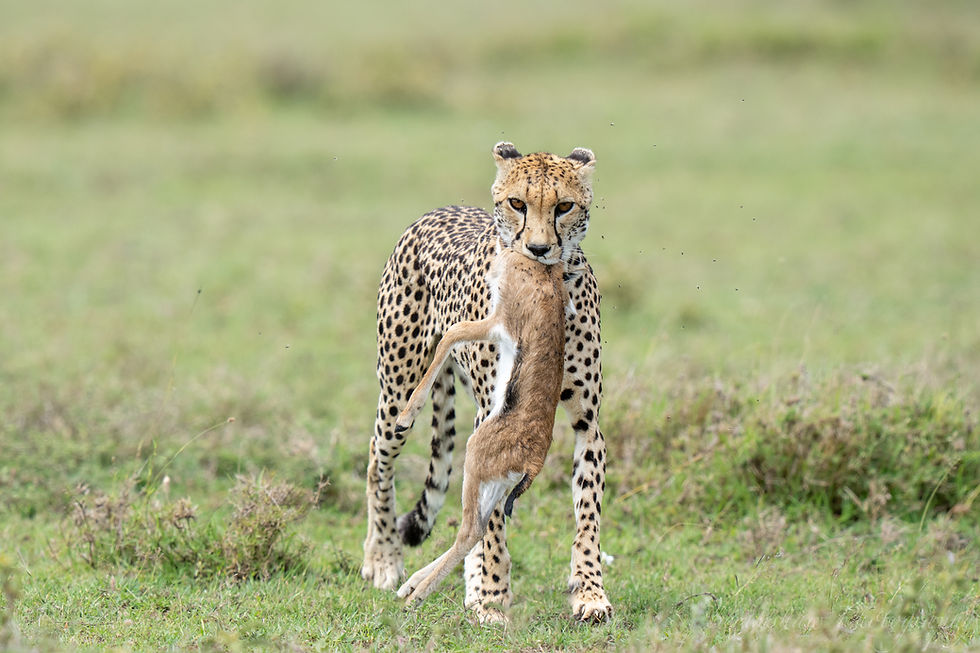
I was learning quite a bit about cheetah behavior just from watching this family. It seems like cheetahs know that they can easily out run a baby gazelle, so there isn't as much pressure to stalk and position themselves like they might be doing for an adult. That's why even though she was relaxing with the cubs, the second she saw the baby gazelle by itself she knew that she could go after it.
As she was eating a herd of wildebeest ran by, and mom started to look around again. I know a baby gazelle isn't that much food, but was she seriously considering hunting again? In a flash, she was sprinting again, and this time I actually got the action shot.


Not even 30 minutes from the last kill, and she had already caught another gazelle! I think they hadn't even finished the last meal before it was on to he next course. I sure hope the gazelle population in Namiri is doing alright, because this cheetah is an absolute terminator.
The light was starting to get harsh, so we left the cheetah family and decided we'd come back to them in the afternoon. When we returned, we found them eating from a dead wildebeest calf. It seems like in the couple hours since we had left, she had made another successful kill!
It was nice spending the evening with them, but unfortunately the rainy season brings large dark storm clouds, which meant I didn't have too much golden light to really photograph the family. Still, I came away with some photos that I was very happy with.




With some good cheetah photos under my belt, I decided that the next day we would try to see if we could find some lions on rocks. We made a plan to head straight towards Gol Kopjes, which is personally my favorite part of the Serengeti. Last year I visited it just for an afternoon on my way out of the park, and we found the mega herds of the Great Migration and lots of big cats everywhere. So this time around I was excited to be able to spend a decent amount of time there.
The thing about safaris though is that you can make all the plans in the world, but if you find something good along the way, all those plans go out the window. As we were driving towards Gol just as the sun started to peak above the horizon, we found two male lions running and roaring loudly. Well it seemed like this was going to be our sighting now.


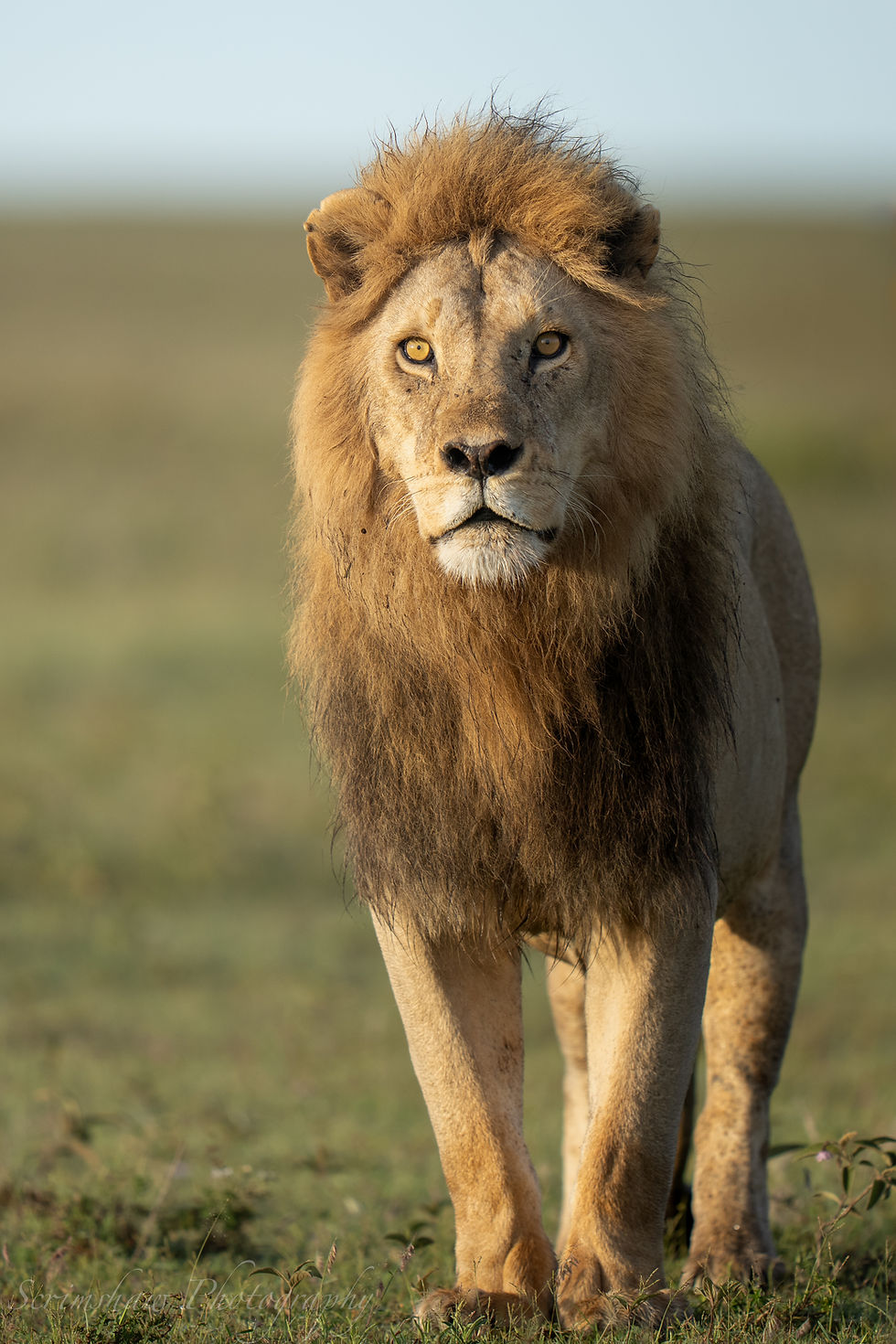




How could I complain about photographing gorgeous male lions first thing in the morning? They seemed to be actively patrolling and letting every other lion around know that this was their territory. And while I had hoped they'd heads towards some kopjes, they decided to lay down and have a rest instead. What a fantastic start to the day!
After a short breakfast, we made our way into Gol, where just like last year, the huge herds of wildebeest and zebra were still hanging around. Everyone loves to watch the drama of the wildebeest crossing rivers and dodging crocodiles, but for me, just driving through the herds and seeing the sheer number of animals around you is the best part of the migration.





Later that afternoon, we decided that we would look for leopards since we had now gotten good photos of both lions and cheetahs. There is one leopard around camp known as Mama Namiri, and if you're going to find a leopard to photograph, she's going to be the one. Mama Namiri also had a 9 month old cub, but it had been a couple of weeks since anyone had seen them, so the odds weren't looking too good.
But she is the only leopard that is comfortable around vehicles, so every afternoon we would start our game drives by driving around and scanning the forests around camp to see if we could spot her. And every day we would come up short. I've had a lot of luck finding leopards in other parts of Africa, so maybe I took it for granted before because I was now realizing how hard it is to find them in landscapes like this.
After giving up on leopards, we headed back towards the kopjes, where we found a pride of lions on top of one large rock. With some storm clouds, building, this was really starting to look like an iconic Serengeti scene. I just prayed that they would come to the edge, and after a bit of waiting, my prayers were answered.
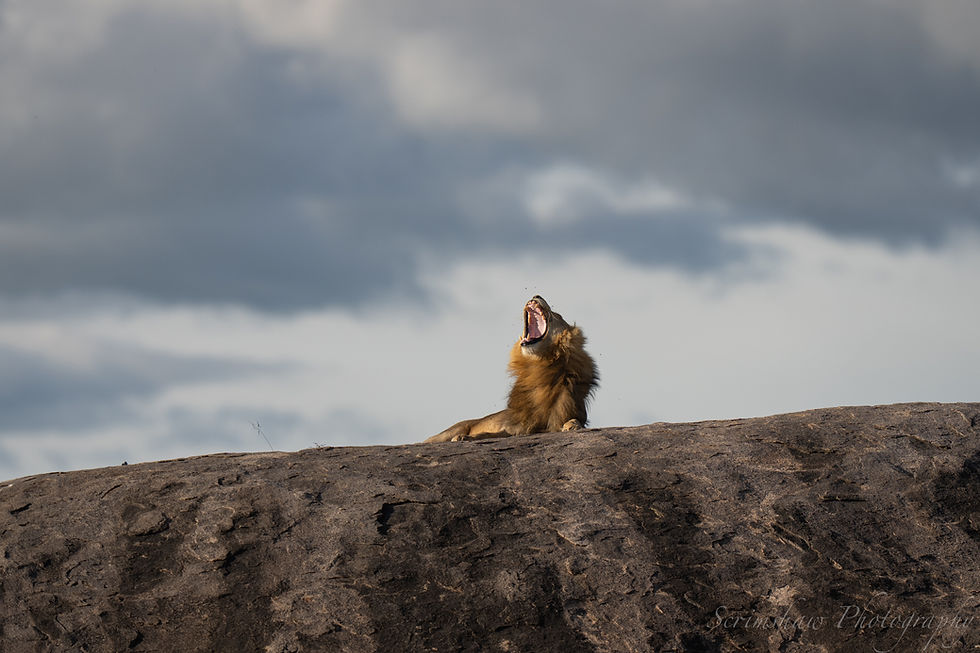







What a scene! Much to my disappointment, we had to leave just before the light was getting really good because we were so far from camp. I had some fantastic shots don't get me wrong, but I knew that I was leaving some truly epic ones on the table because we couldn't wait for that golden light. It's a photographer mindset that I'm trying to shake, but it's still hard to appreciate what you have rather than fixating on what might have been.
The next morning I decided that I really wanted to photograph cheetahs in golden light, so we went out to look for the cheetah with cubs again first thing. Along the way, something caught my eye in the grass. Bat eared fox! And completely relaxed ones too! Normally they can be rather skittish, but these two came right up to our vehicle and posed perfectly.



Namiri is great for these sorts of random small critters, and this was by far my best bat eared fox sighting to date. I got distracted once again from our main target, and at this point there wasn't much golden light left to find our cheetahs. We searched for hours, but had no luck. All we could find were some hyenas on a wildebeest carcass, and with no cheetahs around, I decided to photograph them for a bit.


While we were with the hyenas, another vehicle called in on the radio that they had found the cheetahs. And for the rest of the day, all I photographed were these guys.






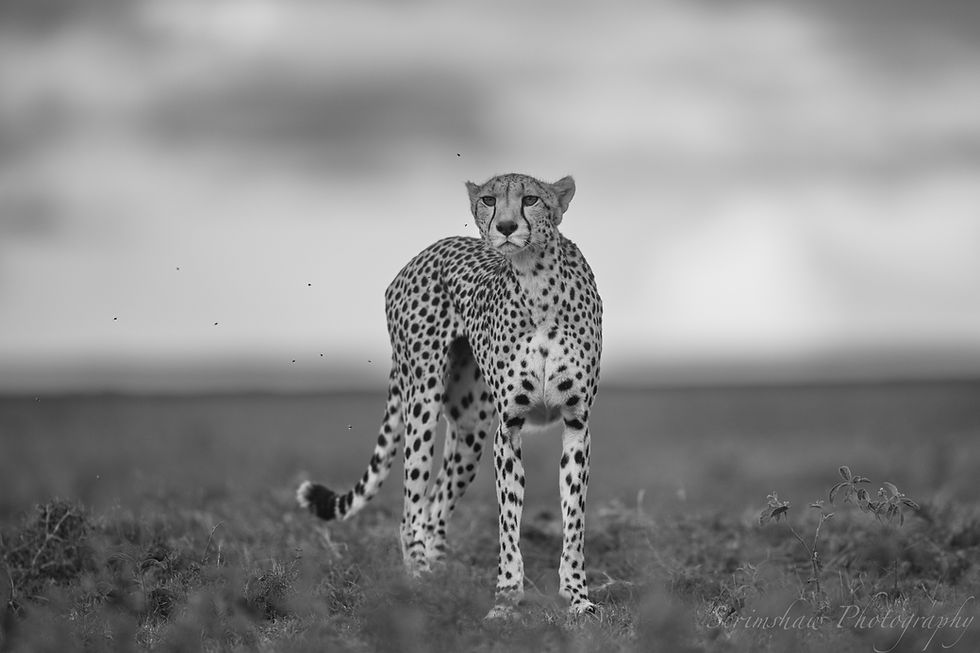



In only a few days, Namiri had solidified itself to me as one of the most productive photographic destinations that I had ever visited. It wasn't just the quantity of photos though, it was the quality. Sightings were almost always exclusive because of how remote this area is, and Seleman was always putting me in the best position for whatever shots I needed. I could have left after only 4 days, and I would have had an incredible portfolio of images.
Luckily I had another week here, and I was going to take advantage of it! The plan for the following morning was to head to some kopjes closer to camp, that way we could be ready for golden hour assuming we found something to photograph. Just as we were nearing the kopjes, we found three male cheetahs on the move. These were the Punda boys, a coalition of cheetahs famous for controlling this area of the Serengeti. As they patrolled and scent marked around, they gave me some amazing shots.


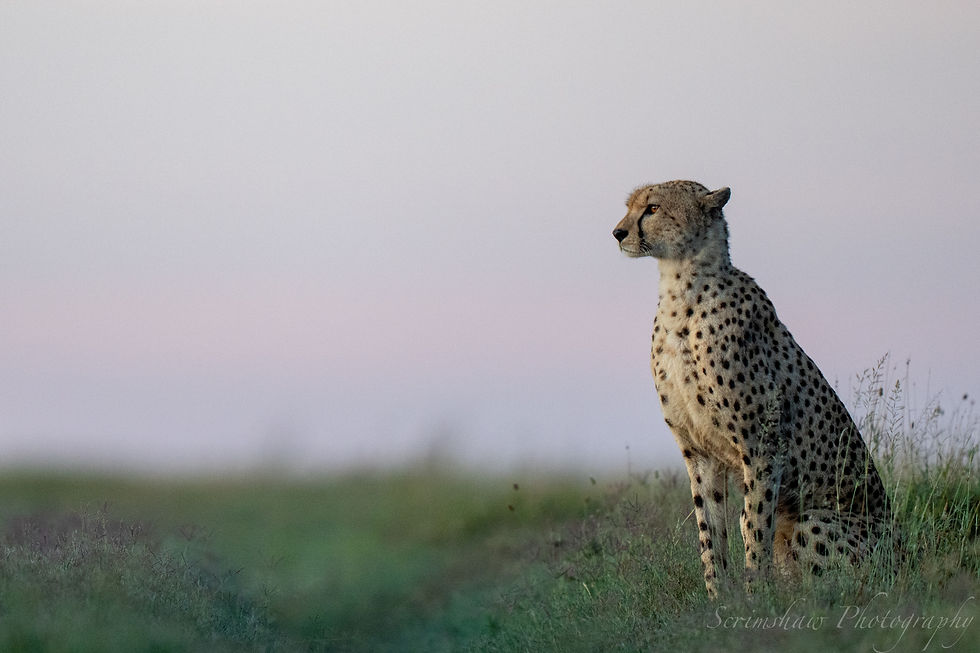




The cheetahs stopped all of a sudden, and started to purr and hiss in ways that I hadn't ever heard cheetahs do. Out of nowhere, a lioness sprinted out of the grass towards them. Evidently that was what they had spotted, and I realized that they were making warning calls. There was no way she could catch them, but it goes to show how vigilant cheetahs have to be to survive in a world of much bigger predators.
We went to investigate why the lioness was so defensive, and we soon realized that she had cubs of her own nearby. This was going to be our sighting for the morning it seemed. As we watched them, mom eventually decided to get up, and I was able to photograph some spectacular big cat behavior unlike ever before.





I've photographed a lioness moving cubs only once before, but this sighting was just next level. And right up next to our vehicle too! Just incredible.
Since we knew that there were lions near kopjes relatively close to camp, we decided that they would be our targets for the afternoon (after a short leopard search of course). And boy did that decision pay off, as I got great photos later of lions on rocks, as well as some very inquisitive little lion cubs.









Lions on rocks. It's why I came to Namiri and boy did it deliver.
The next morning we went to a different group of kopjes, hoping to find some big male lions on rocks too. We found a group of five male lions nearby, and they gave us some great photos even if they were only on the ground.

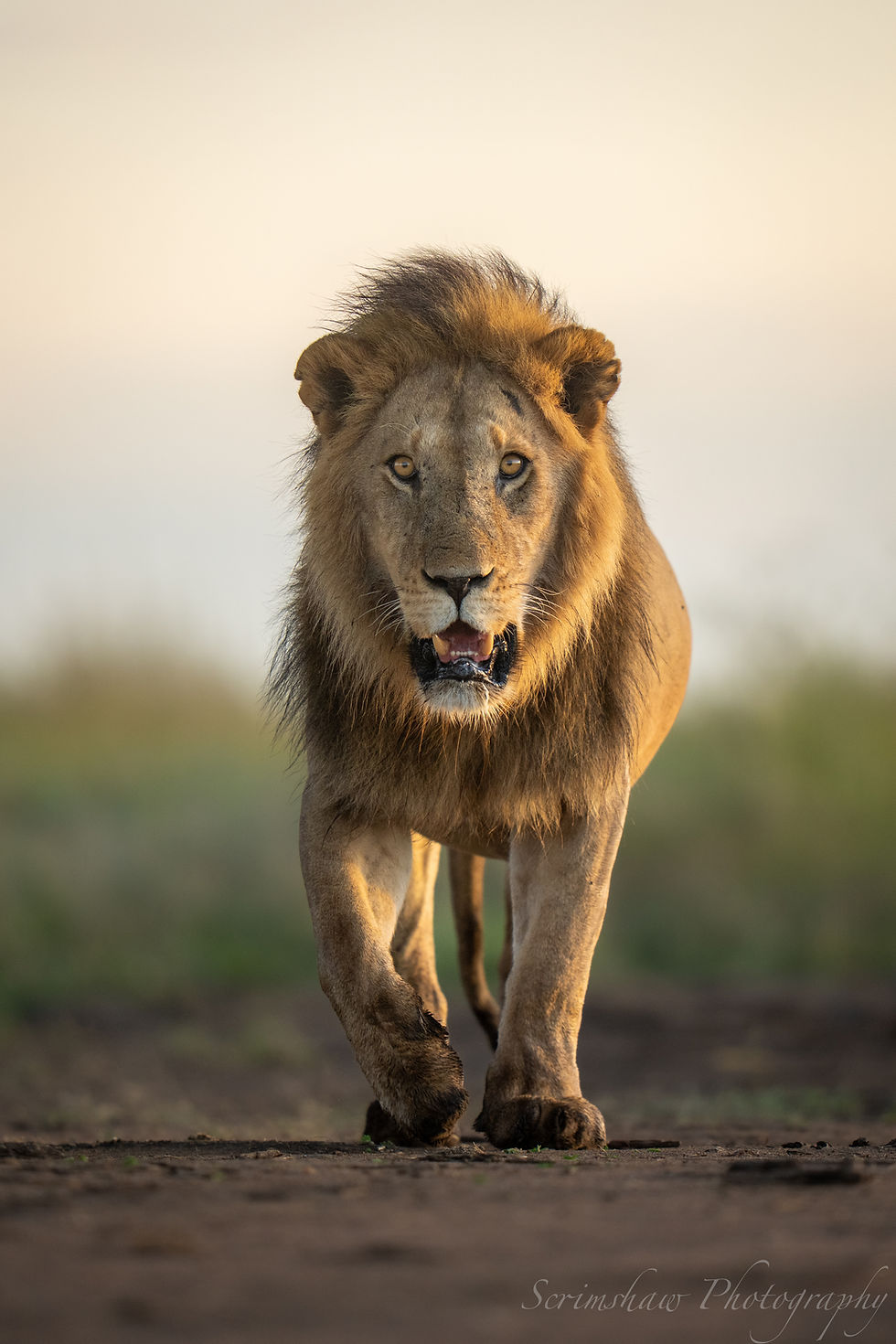

After the lions became lazy, we made our way back to the plains to see if we could find our cheetah family. Somehow they had disappeared on us after the last few days, but another vehicle had spotted a male cheetah that was eyeing a herd of wildebeest very intently. We sat and waited with him, and then just like the other cheetahs, he ran like a bullet straight towards the herd.




I've seen cheetahs hunt before, but I've never been able to photograph them in the way that I was at Namiri. Seleman was always putting my in the perfect spot for just the right moment when the cheetahs were at full speed with their prey. Phenomenal guiding all around.
We called it an early day and went back to camp early. Later that afternoon we made plans to just drive around and see whatever we could see, which was a nice carefree attitude to have after such dramatic sightings the last few days. The relaxation didn't last very long, because not even 5 minutes out of camp we found a lioness carrying her newborn cubs straight towards the staff area of the camp! Apparently she had given birth near the camp, and was frequently seen moving her cubs to and from the different camp facilities and rooms. Talk about wild!


As other vehicles started to show up, the sighting got a bit too crowded for my taste, so we moved on. There were some lions on rocks nearby that gave me some good shots, but then the rest of the camp vehicles started to copy our game drive and we decided to just leave and go find whatever we could. As we were driving, Seleman stopped and scanned all of a sudden. "It's a leopard!" he exclaimed! Finally after searching for a leopard every afternoon, the one day where we just decide to take it easy with no pressure is when we find one.


At first we thought that this was Mama Namiri because of how close we were to camp, but later on we discovered that this was another female named Kisaru. Kisaru is the Swahili word for hope, and Seleman told me that when guides can't find Mama Namiri, they will sometimes hope they can find this leopard instead, which is why she's named accordingly. When it was only us with her she was very relaxed, then another vehicle came and she was slightly less comfortable, and then finally two more camp vehicles came and she completely lost her cool and sprinted down the tree into some bushes. Even if these weren't the most incredible leopard photos of my life, they were so special to me because of how hard we had worked to try and find one.
We went back to the kopjes to photograph lions for the rest of the evening which seemed like a great idea as some dramatic clouds started building.

Then a call came in on the radio. Another vehicle had found Mama Namiri! We didn't even have to discuss it, and Seleman immediately started racing towards her with what little light we had left. She was with her cub at the base of a tree, and much more relaxed than Kisaru was. Her cub is less comfortable around vehicles though, so she posed nicely for me even though he preferred avoiding the camera. Three leopards in one afternoon! I don't usually like to drink on safari, but this was worth celebrating over!

This is where my Serengeti trip hit a bit of a speed bump. Unfortunately Namiri had no availability for one night during my stay, so I had to transfer to a different camp before coming back there later. It was a bit annoying, but it was expected considering how last minute I planned this trip. The camp was located in the south western part of the park near the famous Moru Kopjes, which is home to the very elusive black rhino. My plan was to stay there for a couple of nights, and focus solely on finding rhinos.
When I arrived though, virtually all the roads around that area were completely flooded, and game drives were pretty much impossible. I immediately knew that this just wasn't going to work, so I asked if there was anyway I could go back to Namiri early, and thankfully the logistics team helped make that happen and said I could go back tomorrow. Talk about incredible customer service.
The next day we started to make our way back to Namiri, and I got the chance to photograph around the Seronera area for a change. It was a bit more crowded because of the sheer number of camps around there, but it was a nice change of scenery regardless.




After we made it to camp and had some lunch, we had heard about a leopard in the fever forest nearby, so we set off in that direction first. I actually managed to spot it first by its hanging tail, which I was quite proud of. It was Mama Namiri's son, who was quite shy and eventually ran down the tree into some bushes when the vehicle activity became too much. I thought about waiting him out since it looked like we were going to get a really nice sunset, but he just wouldn't budge, and sadly I had to call it a day and tried to race to some lions to salvage whatever sunset photography I could.


April is a great time to visit the Serengeti because of cheaper rates and dramatic clouds, but it also often means that you don't get a ton of golden light or sunrise/sunset shots because of the cloud cover. As the trip started to wind down, I tried to maximize my opportunities to get good light by sticking closer to camp, and the next day we went out a bit slower just to see if we could find subjects and then wait for the light rather than race to get to any specific location.
It paid off, and we found a pride of lions walking through the tall grass the next morning. The height of the grass made photography challenging, but I navigated it as best as I could.


It was a quiet morning, and not too much activity after the light got harsher and we left the lions. That afternoon we had found the Punda boys near camp, and they had taken down a wildebeest and dragged it into the bushes. No good photos to be had, so we had headed back to the kopjes to find lions on rocks again. That decision was a wise one, and it paid off fantastically with the photos I got.



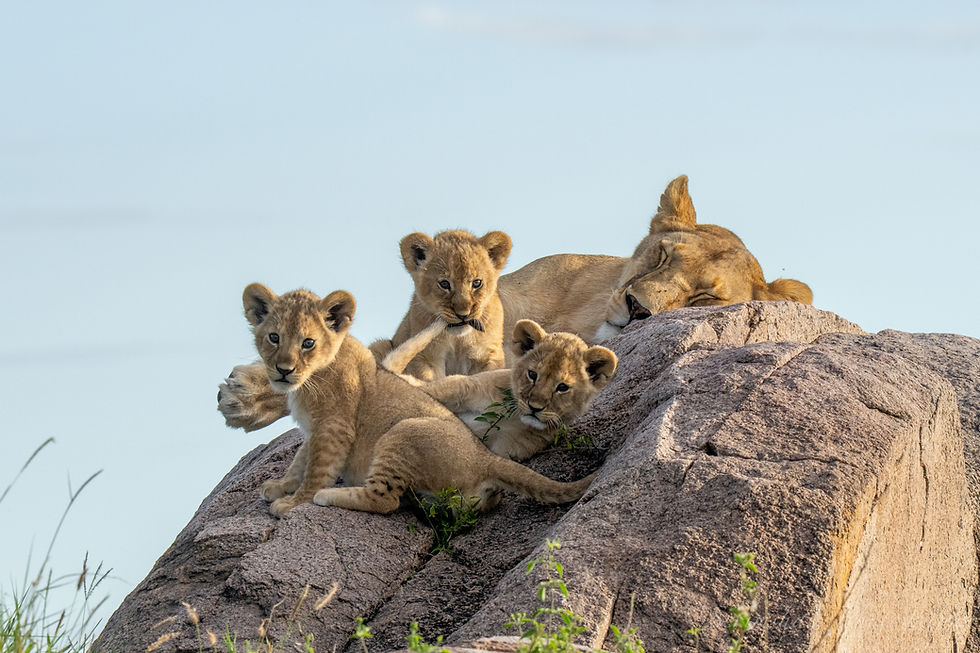

A herd of wildebeest ran by the kopjes and it looked like the lioness might hunt, but they were indecisive and the wildebeest got away unscathed. We stayed with the lions until last light, and at this point we knew that we should head back there first thing in the morning. After all, there were lions on rocks with tiny cubs nearby. It doesn't have to be complicated.


Another group of wildebeest ran by in the morning, and once again the lions seemed to fumble the chance to hunt. Apparently the lions around these kopjes really struggle to raise cubs because of how little food there is around the area. It makes it even sadder knowing that each time they fail to make a kill, the odds of their cubs surviving drops lower and lower.
After a few days without any sighting, another one of our vehicles had found the cheetah mom with her cubs, and so we made our way out towards them. It seemed like she was surveying around trying to hunt, and we decided to sit tight to see where she would go next. As we sat waiting, she sprint towards the opposite direction and grabbed a baby gazelle that we didn't even know was there. How does she keep doing this?








What a machine. In contrast to the lions that were struggling with their cubs, this cheetah mom was doing an incredible job feeding hers. I nicknamed her "the machine", because she was just making kills left and right. Almost every time we found her, she was either making a kill or enjoying her last one. An incredible cheetah mom.
We returned to the lion on rocks that afternoon because we couldn't seem to locate the cheetahs again after searching around a bit. It gave me a chance to shoot a little wider, and capture the kopje environment that so many cats call home in the Serengeti.



I had storm clouds, good light, and lions on rocks. If that doesn't scream "Serengeti", then I don't know what does.
After almost two weeks, it was finally time for me to say goodbye to the Serengeti. We went out early hoping for more lions, but we struck out unfortunately. As we headed towards Seronera, I did get lucky with some elephants, which was a subject that I didn't photograph too much at Namiri. Growing up elephants were always my favorite animal, so it felt almost symbolic that I should end such an incredible trip with them.




What a fantastic trip! It was very last minute, but the quality of photos that I came home with was just astounding. I can honestly say that if I'm coming to the Serengeti, Namiri Plains is the only place that I'm staying. The guiding, exclusivity, and the types of sightings make it an absolute paradise for photographers, and I'm already counting down the days until I can plan my next trip there.



Truly, Namiri Plains is the best! Every sighting you describe is the quintessential eastern Serengeti sighting!